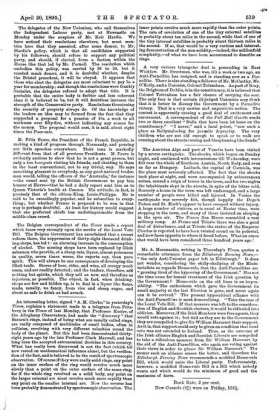An interesting letter, signed " A. M. Clerke," in yesterday's
Times, explains a statement made in a telegram from Pitts- burg in the Times of last Monday, that Professor Keeler, of the Alleghany Observatory, had made the " discovery " that Saturn's rings, instead of being what are usually called rings, are really composed of multitudes of small bodies, often in collision, revolving with very different velocities round the body of the planet. But this had been demonstrated thirty- eight years ago by the late Professor Clark Maxwell, and has long been the accepted astronomical doctrine in this country. What has really been discovered is not the fact (which till now rested on mathematical inference alone), but the verifica- tion of the fact, and is believed to be the result of spectroscopic observation. Of course if they were really solid rings, any point on the inner surface of the ring would revolve much more slowly than a point on the outer surface of the same ring, for if the whole ring revolved as a solid body, any point on the larger external arc must revolve much more rapidly than any point on the smaller internal arc. Now the reverse has been probably demonstrated by spectroscopic observation. The
inner points revolve much more rapidly than the outer points. The rate of revolution of one of the tiny external satellites is probably about ten miles in the second, while that of one of the tiny internal satellites is probably about thirteen miles in the second. If so, that would be a very curious and interest- ing demonstration of the non-solidity,—indeed, the millionfold complexity,—of what we have been accustomed to describe as rings.


































 Previous page
Previous page